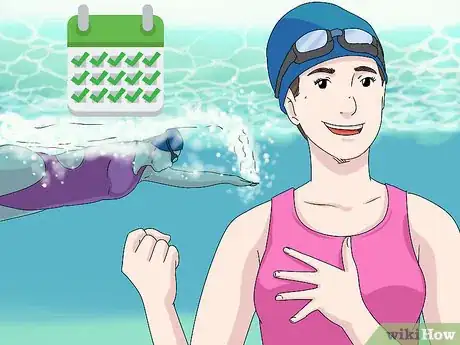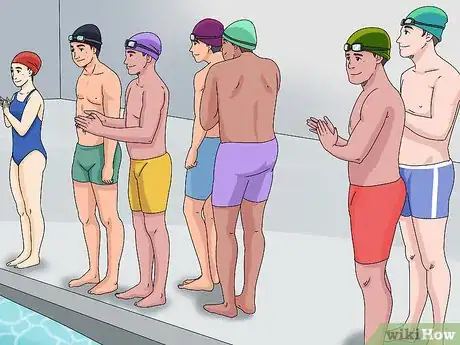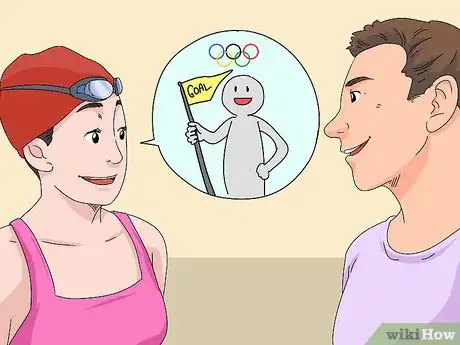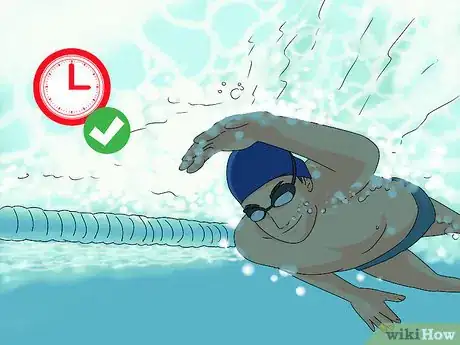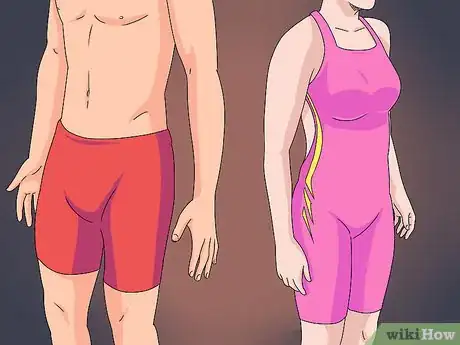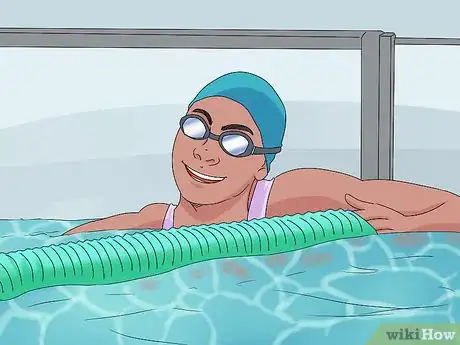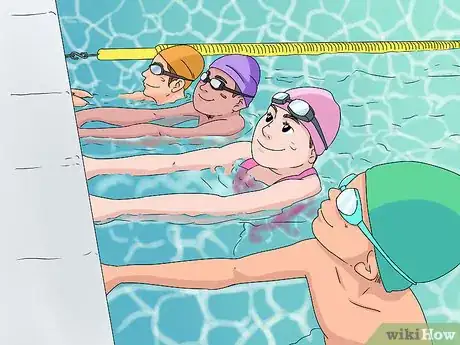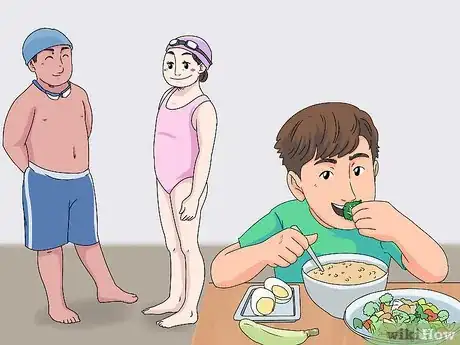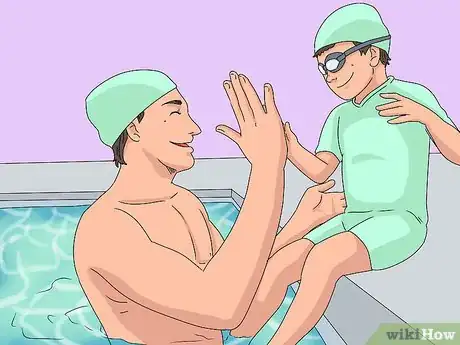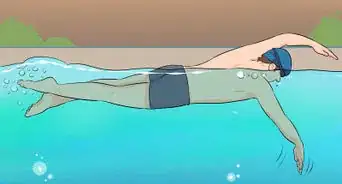This article was co-authored by wikiHow staff writer, Christopher M. Osborne, PhD, and Alan Fang, a trusted member of wikiHow's volunteer community. Alan Fang swam competitively for over 7 years, through high school and into college. He specialized in breaststroke events, and participated in events such as the Speedo Championship Series, the IHSA (Illinois High School Association) state championships, and Illinois Senior and Age Group state championships.
There are 7 references cited in this article, which can be found at the bottom of the page.
This article has been viewed 17,778 times.
Learn more...
Everyone should learn how to swim for safety reasons, and swimming is also a great form of low-impact aerobic exercise. If you’re looking to add a competitive aspect to your swimming, you can join a swim club or team and enter meets. Competitive swimmers need to develop excellent technique in the water, but they also need to nurture a healthy mindset and the dedication to work hard toward the goals they’ve set for themselves.
Steps
Building Your Swimming Skills
-
1Practice the four major competitive strokes. Nearly all swimming competitions involve one or more of the following strokes: freestyle, backstroke, breaststroke, and butterfly. While you may eventually become a specialist in only one of them, you should take lessons in all four strokes to begin with, and eventually perhaps enter competitions in all of them.
- Your coaches or instructors will work with you to develop the essential techniques for each stroke. Listen carefully, and plan to swim lots of laps!
EXPERT TIPAlan Fang swam competitively for over 7 years, through high school and into college. He specialized in breaststroke events, and participated in events such as the Speedo Championship Series, the IHSA (Illinois High School Association) state championships, and Illinois Senior and Age Group state championships.Former Competitive Swimmer
 Alan Fang
Alan Fang
Former Competitive SwimmerFind a coach to critique your form. Alan Fang, a former competitive swimmer, says: "When you're just getting started, it's important to pick out a coach or join a team, because swimming requires a lot of outside guidance. You could be having technical issues with your stroke, but you'll never know until there's someone standing to the side watching you swim.
-
2Improve your stroke efficiency as your technique improves. It’s tempting to think that stroke rate—how quickly you can repeat your swimming stroke—is the key factor in swim racing. However, it’s at least as important to have a strong stroke length—that is, the distance you body covers in the water with each stroke. You have to maximize the efficiency of your movements in the water to excel in swim competitions.[1]
- To maximize your efficiency, you’ll have to work on keeping your body in alignment, you head down, your feet flexible, and other key techniques. Work with your coaches or instructors to improve these skills.
Advertisement -
3Dedicate yourself to a daily training regimen. For competitive swimmers, the “season” can last for 11 months per year. Even if you don’t have the highest aspirations for your competitive future, you need to be willing to embrace a program that involves training, practicing, or competing most days for most of the year.[2]
- Olympic level swimmers may train all year long, 6 days a week, for up to 6 hours per day—with part of that time in the pool, and part of it doing strength training and flexibility exercises out of the pool. You may not need to embrace this level of dedication, depending on your goals, but a 6-day-per-week schedule for at least 1-2 hours per day is reasonable for a competitive swimmer.[3]
Participating in Competitions
-
1Join an affiliated swimming club. Most competitive swimmers are affiliated with a club or team, which in turn is affiliated with an organization that oversees swimming competitions. Depending on where you live, look for swimming clubs that are affiliated with USA Swimming, Swim England, or a similar regional or national swimming body.[4]
- In England, for instance, you must be a member of a Swim England-affiliated club in order to enter sanctioned competitions. Or, you can join Swim England directly for an annual fee and take part in entry-level competitions.
- Check with local schools, YMCAs, or other organizations that have competition-style swimming pools in your area. There’s a good chance they’ll have affiliated swimming clubs.
-
2Establish your personal goals for competitive swimming. If your goal is to someday swim in the Olympics, for instance, you’ll have to dedicate a large chunk of your life to swimming. If you’re just looking to stay fit and enjoy the thrill of competition along the way, your dedication won’t need to be quite so all-consuming.[5]
- Be clear with yourself and your coaches what your goals are. If you overwork yourself based on your goals, you’ll probably burn out and won’t have any fun. If you underwork your goals, you’ll never achieve them.
- Competitive swimmers often face early morning training sessions, 12-hour long meets, lots of travel, and limited time for non-swimming activities. To be a true competitor in the pool, you have to be able to embrace and thrive in this reality.
-
3Meet the time standards required to enter competitions. Entry-level competitions may be open to anyone who is a member of an affiliated club or organization, or the public at large. Higher-level swimming competitions, however, usually require you to achieve certain timing standards in order to be eligible for particular races. Keep training, practicing, and working with your coaches until you achieve the necessary standards.[6]
- Your swimming club will be able to provide you with the timing standards required to enter competitions.
-
4Use aerodynamic swimming gear. When swimming competitively, you’ll want to reduce as much water resistance as possible. This means wearing a form-fitting, aerodynamic swimsuit, and likely a swimming cap if you don’t have close-cropped hair. A pair of goggles that closely fits the bone structure of your face is also a must. Talk to your coach for advice on the best options.[7]
- You may even want to shave your body hair to help you glide through the water just a tiny bit faster.
-
5Follow healthy eating, hydration, and sleeping habits. Swimming burns a lot of energy, so a diet that’s rich in nutrient-dense carbohydrates (like whole grains and legumes), veggies and fruits, lean proteins (like chicken), and healthy fats (such as olive oil) is ideal. Basically, a typical healthy diet for the average person is also a good choice for a swimmer.[8]
- Make sure you drink lots of water before, during, and after practices and competitions as well. The best gauge of adequate hydration is that your urine is light in color.
- Aim for around 8 hours of solid sleep per night as well.
-
6Learn to have a short memory about competitions. Swim meet schedules can be relentless, with limited time between the final round of your first event and the qualifying heats for your second (or vice versa). Win or lose, you have to be able to leave your emotions in the pool and prepare for the next race.[9]
- Even among the greatest swimmers in history, no one is undefeated. After a defeat, think about things you can improve upon, but keep your main focus on the next event.
Getting a Child into Competitive Swimming
-
1Start with “pre-team” or “bridge” swimming programs. Most kids will learn essential swimming strokes and techniques more quickly (and have more fun doing so) in a non-competitive format. This might take the form of traditional swimming lessons; however, local competitive swim clubs might also have “pre-team” or “bridge” programs for younger kids as well.[10]
- “Bridge” programs introduce some of the training aspects of competitive swimming, but reduce the emphasis on winning and losing.
- The American Association of Pediatrics recommends starting formal swimming lessons at age 4. “Parent and child” water classes or other less structured swimming sessions might be suitable for younger children, though.
-
2Watch for signs of burnout due to overemphasis on competition. Some kids thrive in a competitive atmosphere from a young age, and their love of swimming will only grow over time. Others, however, find that the relentless focus on doing more training laps and doing them faster turns their love of swimming into dread.[11]
- If a child starts making excuses about why they don’t want to go to practices or meets, or just seems generally unhappy about swimming, they may be dealing with burnout.
- The child might need to take a break from competitive swimming, or find a program that places less emphasis on competition.
-
3Promote a healthy body image and a healthy lifestyle. Kids who don’t naturally fit the long, lean body type of Olympic champion swimmers might feel inadequate or want to take unhealthy measures to change their body. Remind them that swimmers, like people in general, come in all shapes and sizes, and remind them that their focus should be on fitness, fun, and giving their best effort.[12]
- Make sure child swimmers eat a healthy diet full of healthy carbs, lean proteins, and lots of fruits and veggies, and that they drink water regularly.
-
4Support the child’s goals instead of imposing your own. Trying to turn a child into the champion swimmer you wanted to be is one of the quickest ways to cause burnout. Talk to the child regularly about what their goals are for competitive swimming, and validate these goals with your support and encouragement.[13]
- Swimming competitively can teach lifelong lessons about the importance of dedication, focus, and fitness. But these lessons won’t be learned if a child comes to despise being in the pool.
Competitive Swimming Techniques, Training Schedule, and Career Path
Warnings
- Children in particular should always practice under the close supervision of a coach, instructor, or lifeguard with the proper training, even if the child is a strong swimmer.⧼thumbs_response⧽
Things You'll Need
- Swimsuit
- Goggles and cap
References
- ↑ https://experiencelife.com/article/so-you-want-to-be-a-swimmer/
- ↑ https://www.yourswimlog.com/24-things-learn-becoming-competitive-swimmer/
- ↑ https://www.motleyhealth.com/athletes/michael-phelps-greatest-olympic-swimmer-workouts-and-diet
- ↑ http://www.swimming.org/sport/asa-membership-competitive-swimming/
- ↑ https://www.yourswimlog.com/24-things-learn-becoming-competitive-swimmer/
- ↑ http://www.swimming.org/sport/asa-membership-competitive-swimming/
- ↑ https://www.activekids.com/swimming/articles/5-things-to-know-before-getting-your-child-into-competitive-swimming/slide-6
- ↑ https://www.sportsdietitians.com.au/wp-content/uploads/2015/04/SDA_Junior-Swimmer_Web.pdf
- ↑ https://www.yourswimlog.com/24-things-learn-becoming-competitive-swimmer/
- ↑ https://www.activekids.com/swimming/articles/5-things-to-know-before-getting-your-child-into-competitive-swimming/slide-6
- ↑ http://www.swimwellblog.com/archives/1805/
- ↑ https://www.sportsdietitians.com.au/wp-content/uploads/2015/04/SDA_Junior-Swimmer_Web.pdf
- ↑ http://www.swimwellblog.com/archives/1805/


